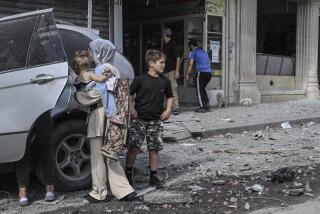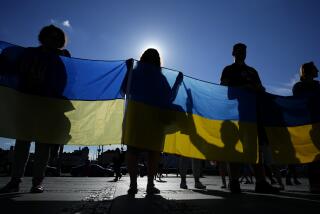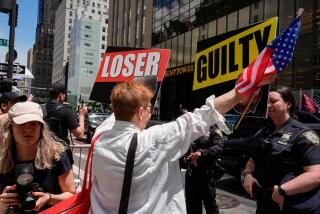The Life and Death of the Cold War: The Long Battle Between West and East : Russia: U.S. policy-makers seemed proud of their ignorance when it came to the Soviet Union, and this led to many wrong moves.
- Share via
SANTA FE, N.M. — A great Eurasian empire is crumbling. Presiding over one of the richest states on Earth, the government cannot feed its people. Everywhere, schemes, inaction, deepening bitterness and despair.
Suddenly, on a foggy March afternoon in 1917, the governance of the empire’s chaos changes hands. “There was this silence,” Winston Churchill wrote. But not for long. The revolution seethes in cold and hunger.
The United States at first welcomes the rebellion. But to deal with the new regime, we send a political fixer--Elihu Root, a Wall Street lawyer and former counsel to Boss Tweed--who wants to keep Russia capitalist and in World War I. “No fight, no loan,” the fixer tells the struggling democrats who need U.S. aid. He is not the last of our envoys to reduce desperation to blind dictum.
Soon the army grows restless, and the crowds will wait no longer. Another regime replaces the infant democracy.
BRUTALITIES OF THE BOLSHEVIKS, banners the usually sedate New York Times. The Soviets are reliably reported to be eating babies.
There is far less news on the U.S., British, French and Japanese interventions to crush the revolution, the horrors of the Russian famine, the actual policies of the new regime. The United States is absorbed in its own great Red Scare. Thousands are arrested and persecuted.
Between the world wars, we literally quarantine the dangerous Soviet state. In chronic weaknesses and turmoil, it is rapidly losing its revolutionary zeal, retreating into traditional Russian foreign policy. Erecting our cordon sanitaire, we succeed, for the most part, in cordoning ourselves off from knowledge.
In the 1920s and ‘30s, Washington deals through Foreign Service officers tutored by aristocratic Russian exiles as contemptuous as they are ignorant of the parvenu Communists. A young U.S. diplomat named George F. Kennan is astonished when he finally meets a Soviet official in 1933. “We suddenly realized,” he wrote in his diary, “that these people we were dealing with were human beings like ourselves.”
The insight is fleeting. U.S. policy will be dominated by more wealthy lawyers and magnates whose secret dispatches deplore the “Boles” and “wretched little kikes” in Soviet ministries. Our inbred decision-makers are of Groton and Yale, shady Long Island estates and Georgetown mansions, prominent without experience, sophisticated without sensibility, differing over polo, but agreeing that the Soviet Union is a distasteful matter.
On walls of Soviet factories and collective farms, the regime barrages its largely illiterate, insular people with lurid propaganda, cartoons of hawk-like, dandified figures labeled “Wall Street Bankers” and “Big Business Lawyers.” Like the matching portrayal in the United States of sinister, bomb-throwing Bolsheviks, the images exploit primitive ideological myths and xenophobia. Yet--the unspoken truth in the United States is that many who determine relations with the Soviet Union give credence to these crude caricatures.
Interlude, World War II.
U.S. lend-lease sends a half-million trucks to Russia (more than Germany possessed), along with 16 million boots and a half-pound of food for every Soviet soldier for every day of the conflict. It is done, Soviets know, while we are fighting a two-front war, with 8 million men absent from our labor force and with a surplus left over. “The kind of feat that concentrates the mind,” says one historian measuring Russian awe of U.S. power. It is also done with an acute American sense of the limits of Soviet military strength, of the need for that help.
Meanwhile, our willful ignorance turns from simple old demonology to the vacant high-mindedness of coalition. Politely overlooked are Soviet atrocities in the Katyn Forest and elsewhere, the grotesqueness of Stalinist tyranny, the mixed blessings of our coming victory with Russian partners expecting territorial booty.
Requiem crescendo. Postwar becomes Cold War.
While Orson Welles’ film villain in “The Third Man” is selling diluted penicillin to sick children in Vienna, a real-life California oilman and major Democratic Party contributor named Edwin W. Pauley leads a U.S. delegation to Moscow to discuss German reparations for the victorious but devastated and impoverished Soviets. Negotiations break down. The Americans smell Russian treachery. Undaunted, Pauley and his team sell their clothes on the Moscow black market for the free-enterprise price of $250 a suit.
Franklin D. Roosevelt had come to think myth or hysteria. “I would minimize the Soviet problem,” he cables Churchill on April 11, 1945. A day later, Roosevelt is dead. The new President is Harry S. Truman--a feisty machine politician from Kansas City, come to the White House with what one biographer will call a “storybook view of history and a rousing Fourth of July patriotism.”
Truman is no match for the forces about to mold him. The second great Red Scare is at hand. As before, the inquisitor’s motives are mixed: genuine ideological fear and repugnance of communism, sheer ignorance and xenophobia--not least, political opportunism.
Architects of U.S. policy would have to make their case “clearer than the truth,” and “bludgeon the mass mind of top government,” as Secretary of State Dean Acheson (Groton and Yale) puts it. They do. The new Central Intelligence Agency begins a systematic overstatement of Soviet military expenditures. Magically, the sclerotic Soviet economy is made to hum and climb on U.S. government charts. To Stalin’s horse-drawn occupation army--complete with shoddy equipment, war-torn roads and spurious morale--the Pentagon adds phantom divisions, then attributes invasion scenarios to the new forces for good measure.
U.S. officials “exaggerated Soviet capabilities and intentions to such an extent,” says a subsequent study of the archives, “that it is surprising anyone took them seriously.” Fed by somber government claims and reverberating public fear, the U.S. press and people have no trouble.
“Russia’s armies and air forces are in a position to pour across Europe and into Asia at will,” U.S. News and World Report announces typically in April, 1948, about the time the Soviet military reaches its postwar doldrums and the Soviet Union sinks into another nightmare of famine and oppression. There is cannibalism in the Ukraine. “In the late 1940s,” one scholarly examination of the record concludes late, “the Red Juggernaut was anything but.”
Byzantine scene, Moscow, 1945-53.
“One day I was walking down that Arbat,” writes Russian poet Boris Slutsky, “and God passed by in five automobiles.” The deity is a small pockmarked man with the adopted name of Josef Stalin, a former seminary student become consummate bureaucrat and hideous tyrant.
The point is never that the Soviets are not a gruesome dictatorship. From the collectivization and purges of the 1930s through war and a new wave of postwar persecution, the human toll is 30 million to 50 million, far worse than even U.S. intelligence officers guess, an almost unimaginable demography of desolation.
Ironically, the American sin lies in so ignoring the devastation, so inflating Soviet strength for our own purposes, so surrendering to ignorance. U.S. casualties of Soviet rule are temperance, judgment honesty. Our parallel tyranny becomes lethal excess, tragic exploitation, fatal obsession over the “threat”--and the toll of that, too, is awesome.
Archives later reveal what governments long knew--that in Greece, Hungary, Czechoslovakia, Egypt, Korea, Vietnam and a dozen other checkpoints, the Soviets play a cynical game, betraying their allies more often than challenging the West. Even in the Berlin crisis of 1961, we now know it is the United States that stages the confrontation, and Russian tanks that react. So it continues into the 1980s, when bristling North Atlantic Treaty Organization exercises trigger periodic war scares in the Kremlin and its terminally ill domain.
Reckonings.
Future generations, less encrusted with shame and cant, will have to figure--and pay--the real bill.
In foreign policy, we spend our aid and moral patrimony on a string of client-tyrants--ignoring, condoning, sometimes abetting everything from solitary torture to tribal genocide in the name of Cold War advantage and stability.
The Vietnam War breaks us, the corruption entering the soul of our economy as well as policy. The weapons-spending orgies of the 1980s merely finish the job.
In the end, as the confirmation hearings for CIA Director Robert M. Gates show in 1991, we have a $30-billion-a-year intelligence operation that couldn’t even tell when our Cold War bed partner died--or worse, no longer had the integrity to admit it, even in secret.
The United States begins the Cold War as the world’s greatest power. It ends it in the fleeting glories of Operation Desert Storm, as a high-tech, debtor constabulary, a blue-collar, eager-for-the-work security service, handling neighborhood delinquents for the more prosperous Europeans and Japanese.
At home, the Cold War’s ultimate casualty is politics itself. Alone among civilized societies, we have no democratic left. So, too, our right has ceased to exist as a principled conservatism, reduced to chauvinist incantation, transparent defense of growing class privilege, the festering of an atavistic racist fringe.
In between--amid the domestic political residue of Cold War--govern the descendants of Thomas Jefferson and Abraham Lincoln, become a unified part of money and incumbency. It is always said that the Soviet system robbed people of authentic political choice. Yes, well.
Three-quarters of a century after the Russian Revolution, our decrepit economy is also made in shoddy Moscow. By 1953, the Fortune 500 already claims more than half the net income of all U.S. industry, and most are beneficiaries of the Cold War budget. In 1991, the United States remains a last bastion of corporate socialism, preserving our own new class of BMW Bolsheviks from Wall Street to Main Street, where tax shelters and special-interest subsidies are never really redressed, Pentagon budgets never really cut, missions never really end.
Look around at our own Cold War-torn landscape of the 1990s. Our starved education, endangered environment, creaking infrastructure, disfigured economy, perverted income distribution, irrational health-care system, needless poverty, wasteful crime, social disintegration. As the Soviet Union ends its grim chapter and strives for the American dream, a triumphant United States resembles more and more czarist Russia.
Peal out the bells of victory. Bury awkward archives. Make suitable speeches. Send fixers to Moscow. There’s nothing like being on the winning side of a revolution, even in winter.
Here lies the Cold War. Rest in uneasy peace.
More to Read
Sign up for Essential California
The most important California stories and recommendations in your inbox every morning.
You may occasionally receive promotional content from the Los Angeles Times.










